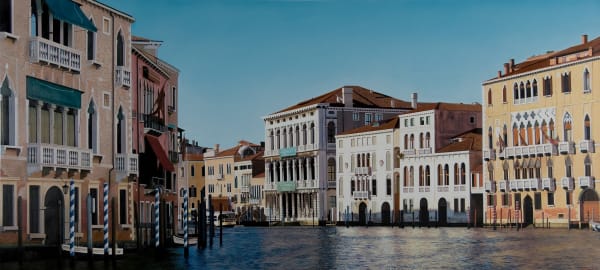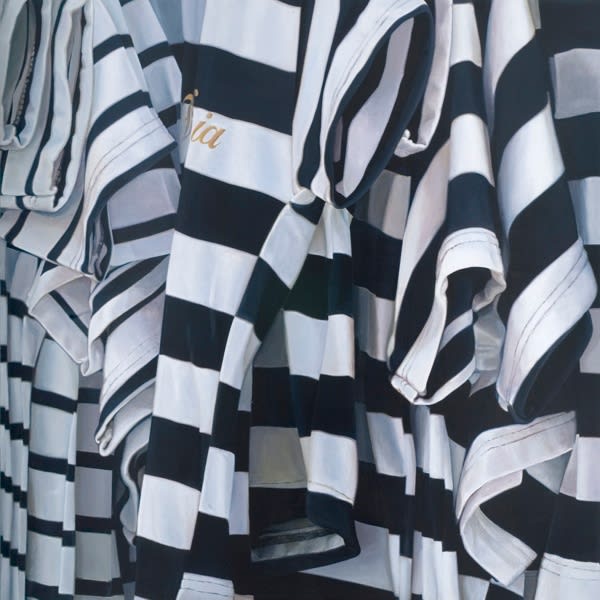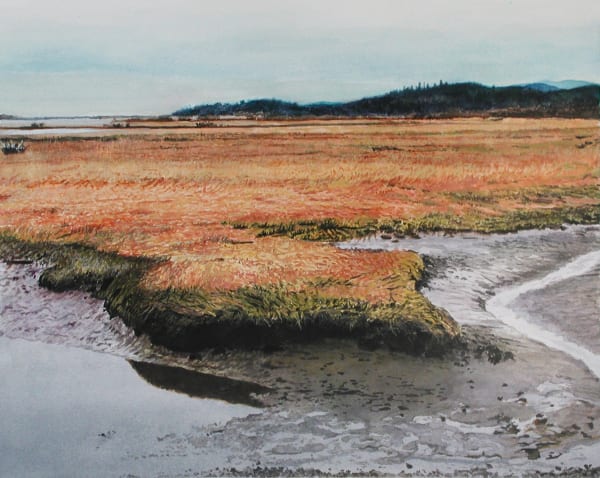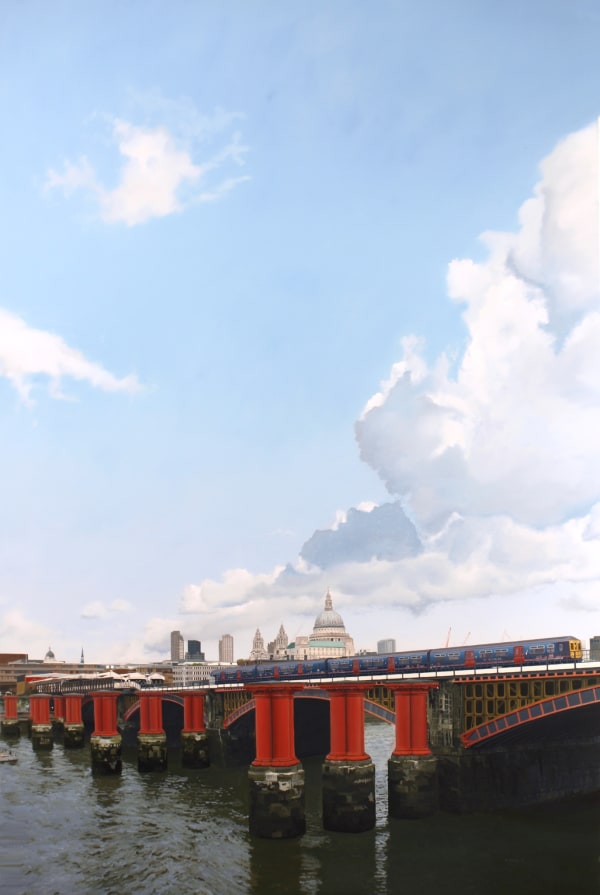Exactitude IV
The fourth in the ongoing series of Exactitude exhibitions, this show presents a selection of contemporary artists working in a realist style. We do not form a declared ‘movement’: there is no manifesto. We have not all met: we come from various, wide-flung places. Some of us are at the beginning of our careers, and some are long established.
All of us are concerned with the figurative, but our interests include many subjects. The show includes work ranging from still life and the extreme closeup [Campos,Poole, Martin, Schonzeit, Beliveau], to large scale urban pieces [Marsh, Rangel, Neffson], and takes in a landscape painter, James Van Patten, with a very specific interest: he concerns himself with water in the wilderness: the point at which earth, water, and sky come together.
Even within these categories, we diverge as we overlap: Paul Beliveau loves books and typography, and conveys by his choices and the adjacency of the chosen titles the meaning their contents hold for him, and perhaps for our common culture. Pedro Campos also likes books - and genre objects - but his interest in lettering extends to the world of commercial packaging. I am similarly ensnared by consumer products and culture, especially “junk foods” such as chocolate bars: I like to celebrate their blaring colours and slogans, and I like the noisy, chance juxtapositions of everyday things: the newsagent’s sweet counter, the magazine rack, the stall of souvenir t-shirts. Tom Martin’s choice of objects is equally quotidian, yet entirely different: his gleaming machine components are at once banal and mysterious, reflecting a world that we all inhabit, but just out of focus, not quite identifiable.
Francisco Rangel and Robert Neffson are both painters of cityscapes, but their interests diverge: Neffson has been described as a “romantic humanist”, and depicts the human bustle of the large American city, while Rangel, who trained as an architect, is particularly interested in built structures like bridges, their historical and cultural expressivity, and how they add to the unique flavour of each city. Christian Marsh paints places that he has visited, theses are the paintings of a modern Grand Tourist, where people and buildings are equally fascinating, and also clearly seen through foreign eyes.
Most of us exhibit a “modern” attitude: this is most often manifest in the direct and faithful reproduction of aspects and objects of everyday life now. In some cases [Ben Schonzeit and Paul Beliveau] there is a clear interest in the richness of history and culture, nevertheless this is a modern interest. But are the landscapes of James Van Patten “modern”? Perhaps: behind our changing cities and ephemeral artifacts his enduring wilderness is always there; opposing and balancing the city; a kind of bedrock desirable to many when overwhelmed by our urban excesses.
All of us work in a meticulous fashion, and the brushstroke is subservient to the image, not a means of producing a textured surface; indeed some artists such as Tom Martin, have eliminated it altogether by switching to the airbrush. But the results are not at all identical: Campos, for example, achieves an extraordinarily exact - even glacial - effect; while Rangel works in a looser and more suggestive way.
All of us are interested in the possibilities of the photograph. Tom Martin loves the limitations of the camera lens and the fuzziness beyond the focused depth of field area of the extreme photographic closeup, and James Van Patten uses the additional richness in lens anomalies to enhance his landscapes. [So if his pieces are notmodern, they are achieved in a modern way…. ]. Some artists, such as Robert Neffson, use photography alongside sketching and observation, to know the subject and to analyse it. Several, for example, Christian Marsh, use it to capture a specific moment, to fix the light in a way that Monet must have dreamed of. Ben Schonzeit often collages several photographic images in a dreamlike way in his flower paintings to suggest all kinds of cultural and historical possibilities. Paul Beliveau phographs his books and transfers the results to the computer, eventually working from a digital image. My method also includes digitising dozens of photographic images for each picture, composing, collaging, warping, and colourising on the computer before returning to object, canvas and paint.
So: similarities and differences. Who do we think we are? There is some dialogue in the shared observance of contemporary life, and there is some agreement in paint….. Ultimately though, we are - diverse - observers, looking with precision at a mostly urban world composed of artifacts, buildings, cities… and all of this highly informative of its inhabitants; and we strive to convey as exactly as we may, what we see, near and far, and what it may signify.
Written by: Cynthia Poole; September, 2008
-
 Paul Beliveau, Les humanités CCCLII: L'art
Paul Beliveau, Les humanités CCCLII: L'art -
 Paul BeliveauLes humanités - A Strange Day (CCCXCIII)Acrylic on canvas102 x 152 cm
Paul BeliveauLes humanités - A Strange Day (CCCXCIII)Acrylic on canvas102 x 152 cm -
 Paul BeliveauFree Fall (Les humanités CCCXCIII)Acrylic on canvas102 x 152 cm
Paul BeliveauFree Fall (Les humanités CCCXCIII)Acrylic on canvas102 x 152 cm -
 Paul BeliveauFellini (Humanites CCCLIII)Acrylic on canvas122 x 91 cm
Paul BeliveauFellini (Humanites CCCLIII)Acrylic on canvas122 x 91 cm -
 Pedro CamposRhapsody in Redoil on canvas150 x 150 cm
Pedro CamposRhapsody in Redoil on canvas150 x 150 cm -
 Pedro CamposJellybeansoil on canvas195 x 97 cm
Pedro CamposJellybeansoil on canvas195 x 97 cm -
 Christian MarshCa 'RezzonicoOil on canvas38.5 x 87"
Christian MarshCa 'RezzonicoOil on canvas38.5 x 87"
98 x 220 cm -
 Tom Martindéjà vuAcrylic on canvas68.5 x 114.5 cm
Tom Martindéjà vuAcrylic on canvas68.5 x 114.5 cm -
 Tom MartinWholewheatAcrylic on canvas100 x 100 cm
Tom MartinWholewheatAcrylic on canvas100 x 100 cm -
 Tom MartinThree GlassesAcrylic on canvas114.5 x 152.5 cm
Tom MartinThree GlassesAcrylic on canvas114.5 x 152.5 cm -
 Cynthia Poole, KitKat Chunky XI
Cynthia Poole, KitKat Chunky XI -
 Cynthia PooleSt.Marks SqAcrylic on linen47 x 47"
Cynthia PooleSt.Marks SqAcrylic on linen47 x 47"
120 x 120 cm -
 Cynthia Poole, Media Studies - study
Cynthia Poole, Media Studies - study -
 James Van PattenOregon CoastWatercolour paper94 x 119.5 cm
James Van PattenOregon CoastWatercolour paper94 x 119.5 cm -
 James Van PattenOne MorningWatercolour paper25.5 x 33
James Van PattenOne MorningWatercolour paper25.5 x 33 -
 James Van PattenAnybody's CoastWatercolour paper27 x 34 cm
James Van PattenAnybody's CoastWatercolour paper27 x 34 cm -
 James Van PattenDay GoneWatercolour paper27 x 34 cm
James Van PattenDay GoneWatercolour paper27 x 34 cm -
 Francisco RangelLondonoil on canvas130 x 195 cm
Francisco RangelLondonoil on canvas130 x 195 cm -
 Francisco RangelTrainOil on Canvas195 x 130 cm
Francisco RangelTrainOil on Canvas195 x 130 cm


























